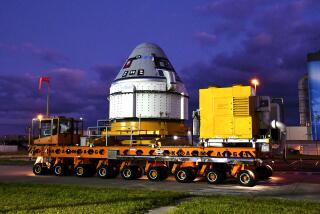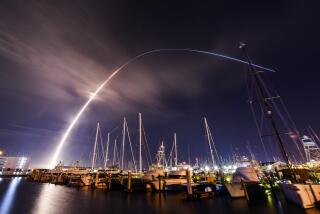Minor Leak Reported on Space Shuttle
- Share via
KENNEDY SPACE CENTER, Fla. — Icy propellant trickled from a leaking jet aboard the space shuttle Discovery on Friday as the orbiter chased a Russian space station around Earth for a historic rendezvous early next week.
Mission Control assured the five Americans and one Russian aboard Discovery that the leak was minor and, if it did not worsen, would have no impact on Monday’s close encounter between the shuttle and the orbiting Mir station.
If the leakage increases, the crew will have to go to the extreme measure of shutting off all three jets in that section. Discovery still would rendezvous with Mir but would have to stay at least 1,000 feet away instead of coming within 35 feet.
“We’re hopeful that the leak will resolve itself and stop,” Mission Control told the astronauts as they wrapped up their first workday in space. “Right now, it does not affect your rendezvous.”
The steering jet failed and began leaking nitrogen tetroxide shortly after Discovery reached orbit early Friday.
Commander James Wetherbee and pilot Eileen M. Collins, the first woman to pilot a U.S. spaceship, turned the seeping jet toward the sun to melt any frozen fuel that might be preventing the thruster valve from closing. This has stopped leaks before.
The jet was losing two to three pounds of propellant per hour, considered a manageable rate of seepage, NASA said. It posed no safety hazard to the crew.
The leaking thruster is one of two that failed. They are among 38 large steering jets on Discovery.
The 250-mile-high rendezvous is the top priority of Discovery’s eight-day mission. It is intended as practice for the first shuttle-Mir docking in June. The National Aeronautics and Space Administration insisted before the flight that the June docking would proceed whether this rendezvous was accomplished or not.
The astronauts kept ahead of schedule despite the leaking thruster and other equipment problems. They began work on the more than 20 experiments in Discovery’s small laboratory and cranked up the shuttle robot arm.
More to Read
Sign up for Essential California
The most important California stories and recommendations in your inbox every morning.
You may occasionally receive promotional content from the Los Angeles Times.













